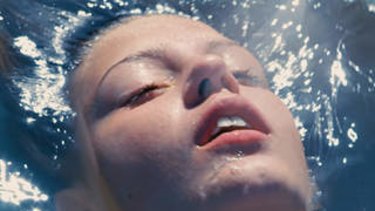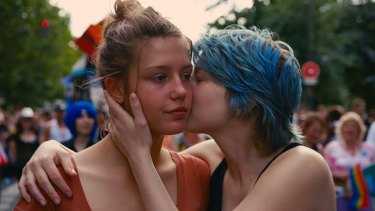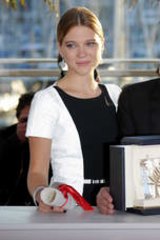How Did They Film Blue Is the Warmest Color Sex Scene
- Culture
- Celebrity
This was published 8 years ago
What really happened on the Blue is the Warmest Colour set
The swirl of hostility, accusations and counter-accusations, retribution and jeering from the wings that has enveloped Blue is the Warmest Colour, the French erotic epic that was the toast of last year's Cannes Film Festival, makes most of Hollywood's catfights look pale by comparison. ''Directors and actors being what they are, they like a good argument,'' wrote a commentator in a piece comparing the saga with other screen clashes. ''On one side are obsessive perfectionists, on the other self-involved exhibitionists, or so the theory goes.'' Is this true of the Blue winning team? Almost certainly, but with the added spice of Frenchness.
Blue is the Warmest Colour is quite extraordinary. The film, directed by Abdellatif Kechiche, a French director of Tunisian origin widely regarded as one of French cinema's small handful of masters, is the story of a great passion between two teenage girls. It traces their affair from flirtation through a bitter break-up and its melancholy aftermath with such force of feeling that you seem to be living their lives yourself.

Blue is the Warmest Colour. Credit:null
So overwhelmed were the members of the Cannes jury that they decided to give the Palme D'Or not only to the director, but, in an unprecedented move, to the two actresses, Lea Seydoux and Adele Exarchopoulos, as well.
The thrilled threesome were pictured on the red carpet kissing and hugging. In private, says Kechiche, Seydoux wept with joy.

A still from Blue is the Warmest Colour. Credit:Transmission Films
That was at the end of May. Then the backlash flipped into action. Immediately after the Cannes premiere, a French film technicians' union criticised Kechiche for his ''disorganised'' approach to filming and for making demands on his crew that amounted to ''moral harassment'', a charge he denied. At the same time, Julie Maroh, the author of the graphic novel on which the film was based, publicly criticised the film's ground-breaking sex scenes, describing them as ''ridiculous'' and questioning whether there had been any real, live lesbians on Kechiche's set.
''It was a brutal and surgical display, exuberant and cold, of so-called lesbian sex, which turned into porn, and [made] me feel very ill at ease,'' she wrote. Nothing Maroh said could douse the critics' rapture, however. Blue is the Warmest Colour was now a festival favourite, with the intensely serious Kechiche and its young stars asked to give dozens of interviews.
As their stock of stories gathered momentum, however, Kechiche began to emerge as something of a monster. Seydoux, the elder of the two actresses at 28, was quoted at Telluride Festival as saying, to website The Daily Beast, that working on the film was ''horrible'' and that she had felt ''like a prostitute''. In the same interview, Exarchopoulos recounted how the director drove them on during a scene of a break-up. ''You can see that we were really suffering. She was hitting me so many times, and [Kechiche] was screaming: 'Hit her! Hit her again'!''
Both actresses had said similar things at Cannes, when the film was in its first heady rush of success. Talking about filming the sex scenes, the longest of which was filmed over 10 gruelling days, Seydoux said: ''It was sometimes embarrassing and sometimes illuminating, surrounded by three cameras in a very small room. Sometimes you could spend like five hours on a scene. I felt like a prostitute.''

All smiles: Lea Seydoux (left), director Abdellatif Kechiche and Adele Exarchopoulos in Cannes. Credit:AP
She then went on to say how normal it felt, even when a model-maker came to make moulds for the silicone shields they wore over their genitals. By the time they reached America, however, this reflective series of observations had been recast as fury.
Kechiche responded with fury of his own. Two days later, he told a press conference in Los Angeles that it was obscene for these young women to claim they had suffered. ''How indecent to talk about pain when doing one of the best jobs in the world!'' he said. ''How, when you are adored, when you go up on the red carpet, when we receive awards, can we speak of suffering?''
A month later, Kechiche wrote an open letter to Rue 89 news website that appeared to accuse the ''arrogant, spoilt'' Seydoux of slander and suggested she could explain herself in court. The website responded by suggesting he could be seen as paranoid.
''Fine! It's better than being called 'tyrant' or 'despot','' he snapped back. ''At least it's a classified illness.''
There is no question that making Blue is the Warmest Colour was intense, immersive and extremely demanding, especially for Exarchopoulos, who was only 18 and dropped out of school to make the film. Sometimes they worked for 18 hours a day, although on other days Kechiche announced they were just going to drink coffee and talk.
The shoot, supposed to take two months, took five. Individual scenes were done dozens of times. Kechiche thinks he amassed 250 hours of footage. He didn't just shoot on set, either. Exarchopoulos woke on a train to Lille after a day off to find he was filming her, whereupon he instructed her to go and buy some snacks and eat while he filmed. ''It was like a constant improvisation,'' she says. Sometimes it seemed to her she was spending whole days crying.
It was Seydoux, despite being racked by her own doubts - ''Sometimes I'd go: 'I'm so shit; I am such a bad actress''' - who coaxed her through it. ''Sometimes she was saying, 'Oh, this is very difficult', and I was saying, 'Think about the film. I know it's so hard for you, but you will see, the film will be great and you will have a lot of success with it'.'' But both of them had expected it to be hard. To declare that there were times they wanted to give up, even that they wouldn't want to go through it again, is not an indictment.
Speaking to The Guardian in November, Exarchopoulos confirmed that ''this film is the best thing I have done in my life''. To me, she said: ''I don't know whether it has really changed me, but it's made me develop and grow. I think I have become grown up and mature.''
The public feud between the Palme D'Or winners, however, was to have a few more twists. By the end of September, after another triumphant outing at the Toronto Film Festival, Kechiche was telling the press the film should never be released because it was ''too sullied'' and it would be impossible for anyone to view the film ''with a clean heart and a watchful eye''.
The stories about him, he told French magazine Telerama, had left him feeling ''humiliated, disgraced. I felt a rejection of me; I live like a curse''. Although this comes not from Kechiche himself but from Exarchopoulos, there have been racist jibes on the internet about an Arab persuading young French girls to take off their clothes.
There was another round of interviews for Blue is the Warmest Colour in London before it opened in November. An interviewer for The Guardian saw Exarchopoulos greet Kechiche warmly in the corridor as they went to their respective interview rooms and asked whether the feud had been exaggerated. ''No, it was real, but it was not as big as it looks,'' she replied. ''For me, a shoot is a human adventure, and in every adventure you have some conflict.''
Kechiche's problem, she said, was his naivety. He was easy prey for pot stirrers. ''In every shoot, between the actor and the director there is manipulation. I'm not saying that negatively. It's healthy. Abdellatif records a lot of takes, so that you can let go.''
But the saga has left Kechiche feeling deflated. Even the opening in France was an anti-climax he compared to a dismal wedding.
Kechiche is 52. In part, he said, he wanted to recapture for himself that age ''when we build each other, we are building our own personality and the way we are going to be as adults''. He could ''retrieve the young man I was at one point'', but he also wanted to mark the point of generational change. ''I almost wish I was born now, because young people seem to be much more beautiful and brighter than my generation,'' he said. ''I want to pay them tribute.''
■ Blue is the Warmest Colour opens on Thursday.
Most Viewed in Culture
Loading
allenhiseadmose87.blogspot.com
Source: https://www.smh.com.au/entertainment/celebrity/what-really-happened-on-the-blue-is-the-warmest-colour-set-20140208-32885.html
0 Response to "How Did They Film Blue Is the Warmest Color Sex Scene"
Post a Comment